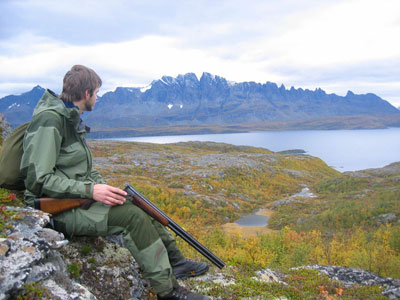Skaga
Jakt, fiske og hytteutleie
Fishing, Hunting and Recreation
SEA ANGLING: The fiord of Kvænangen has multiple species of fish. Very favourable conditions for cod, saithe/coalfish and catfish. Furthermore, there is haddock, halibut, redfish, sea-trout and salmon. The world’s third biggest cod taken by an angler, is from this area (41,5 kg). Fishing equipment can be borrowed and your own dinner is guaranteed!
TROUT: Three good lakes about one hour walk from the hut.
BERRIES: Red whortleberries, blueberries, cloudberries and lots of crawberries - and mushrooms.
 PTARMIGAN: The available area is around 2.000 square da. and very good for wingshooting for two-three persons. Season starts 10th of September.
PTARMIGAN: The available area is around 2.000 square da. and very good for wingshooting for two-three persons. Season starts 10th of September.
GEESE: The number of geese is growing and many nest on the island. Hunting season starts 20th of August, but after a couple weeks the geese leave the area. Lots of geese stop on the island in spring and fall during their yearly trek to and from Spitzbergen
BIRDLIFE: Skaga is a very fascinating place for birdwatchers. Here one find wading birds, different birds of passage and colonies of sea gulls and sea-swallows. Different kinds of sea gulls, grey geese, eider ducks and sea eagles breed in the area. The eagle is to be seen every day. A generation ago, the picking of eggs was of big importance and still people pick eggs in the first weeks of May for home consumption.
CULTURE TRAIL: Spildra is well known for its cultural heritage. People have been living on the island for 8.000 years, which have resulted in quite a few important archeological findings. Most of the cultural monuments are of Sami origin, the Sami being the indigenous people of the area. Examples are sites where the Sami had their turf huts, sacrificial sites and human graves under the rocks. The bear was a holy animal in the old Sami religion and the hunt and burial of the bear had great ritual importance. On Spildra one finds the largest number of bear graves in Scandinavia. Furthermore, there are also traces of a Viking settlement, including the remains of a huge boat house, which tells of a rather close contact between Sami and Norwegians. Most of these cultural monuments can be viewed by following a cultural trail and read a special booklet made for this purpose.